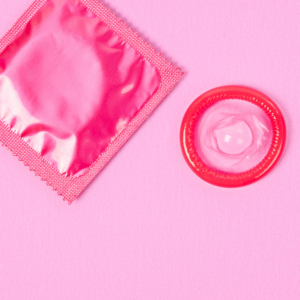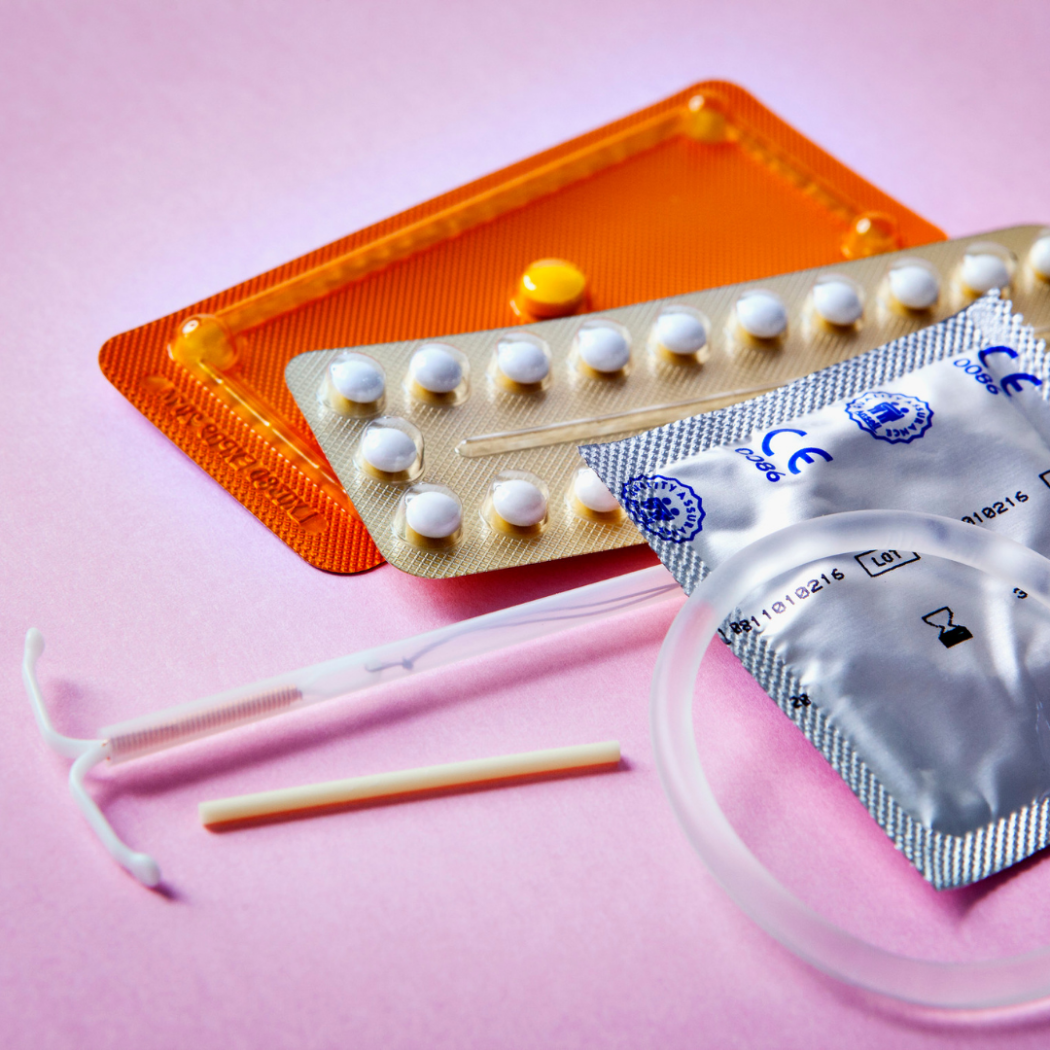 Pills. Patches. Shots. Rings. IUDs. Implants.
Pills. Patches. Shots. Rings. IUDs. Implants.
All of these are different forms of hormonal contraception – also known as “birth control” – which can help a person with female reproductive anatomy regulate their hormones, have healthier periods, and prevent unwanted pregnancy.
Contrary to popular opinion, hormonal contraception is not only useful for people who are sexually active. Contraception that contains hormones, such as estrogen and progestin, can help women with a range of reproductive health concerns, such as managing painful, irregular, or heavy periods or endometriosis, and can help other health issues like acne and endocrine imbalances.
On the other hand, non-hormonal methods – such as condoms, diaphragms, cervical caps, and sponges, contain no hormones and thus are used only for pregnancy and STIs/STDs prevention.
Education on all the different types of contraception is key to selecting what will work well with your body and lifestyle. Although the decision to start or stop birth control should always be made in cooperation with a doctor or nurse, going into your appointment armed with information and secure in your personal preferences will help you find the best method for you.
Healthcare professionals are legally and morally bound to give you honest information. Try to stay away from misleading information and horror stories on the internet about different contraceptive methods. More often than not, people post these videos for the shock value and chance to increase their views, rather than a desire to provide pregnancy-capable people with honest information. Instead of looking to the internet or social media, try asking women you know and trust about what methods worked well for them, ask your doctor which methods are safe for you, and trust your gut as the leading-expert on your own body. Remember, preventing STIs/STDs and unintended pregnancy is an important part of protecting your overall physical and mental health. You deserve to take advantage of the different methods and technology available to safeguard your health and reproductive freedom!
Most importantly, don’t give up hope. Finding the right birth control almost always takes some trial and error. However, there is a 100% guarantee that one of the existing methods below will work for you, and being able to enjoy sex with less fear of unintended pregnancy and infection is well worth it!
Below, we divided different methods of contraception into two different categories: contraception that protects against pregnancy and STIs/STDs and contraception that only protects against unintended pregnancy.
—
Introducing… the ONLY contraception to prevent STIs/STDs: Condoms
The only way to prevent against STIs/STDs is to prevent partners from exchanging fluids (vaginal discharge, semen, blood) AND providing a barrier between direct genital-to-genital contact. No hormonal methods of birth control provide this necessary preventative function. Currently, only condoms and dental dams provide protection against STIs/STDs.
CONDOMS
For penetrative sex (penis-in-vagina or penis-in-anus) and oral sex on a penis.
Condoms come into two forms – internal and external. Internal condoms are worn inside the vagina and provide a barrier between the vaginal canal and a penis. External condoms provide the same barrier but are instead worn on an erect penis. Each method provides a barrier between genital-to-genital contact and prevents pregnancy by stopping semen from entering the vagina.
Condoms are a great option for pregnancy prevention and the only option for STI/STD prevention. Everyone who engages in penetrative sex should have some (non-expired) condoms on hand.
DENTAL DAMS
For oral sex on a vulva, vagina, or anus.
Dental dams are a flat, thin, rectangular pieces of latex or polyurethane that are worn over the vulva or anus, providing a barrier between the mouth and genitals. The giving or receiving partner can hold the dam in place during oral sex. It is important to note that dental dams do not protect against pregnancy and thus are not meant for penetrative sex.
Don’t have dental dams on hand? You can also make your own dental dam from a condom.
The Facts:
- Condoms are 79-87% effective at preventing pregnancy
- Worn on an erect penis (external condoms) or inside the vagina (internal condoms), new condom used every time
- Pros: only contraception to protect against STIs/STDs, available at many stores, putting on can be part of foreplay
- Cons: can decrease sensation, can slip out of place or tear
Learn more about internal condoms.
Hormonal Contraception
Broken down by how often the pregnancy-capable person needs to think about or attend to a certain method for it to work!
All hormonal contraception works in a similar way – by providing your body with hormones that prevent your ovaries from releasing an egg, as well as thickening the cervical mucus. This prevents sperm from being able to fertilize an egg, resulting in pregnancy. The hormones in contraception, estrogen and progestin, are the same as the naturally-occurring reproductive hormones that are already present in your body. Hormonal contraception works by providing your body with these same hormones on a different schedule than your typical menstrual cycle, thus preventing ovulation and lowering the chance of pregnancy.
Remember, all hormonal contraception needs at least seven days after the start date to lower the risk of unintended pregnancy. None of these methods work right away! If you need protection against pregnancy without the wait, use condoms.
Think about it… every day
ORAL CONTRACEPTIVE PILLS
Oral Contraceptive Pills (OCPs), commonly known as “the pill,” are one of the most popular methods of hormonal birth control. For the pill to work, you have to take it the same time every day. It is important to note that OCPs come in two major types: combined estrogen/progesterone pills, and progesterone-only “mini pills.” Mini pills work for pregnancy-capable people who are medically unable to take estrogen.
The Facts
- 93% effective at preventing pregnancy
- Must take pill at the same time every day
- Pros: can improve PMS symptoms, make periods more regular, and improve acne
- Cons: can cause spotting, nausea, headaches, and changes in sex drive
Think about it… every week
THE PATCH
The Patch works the same way that OCPs do, by providing your body with hormones that prevent ovulation and thicken the cervical mucus. However, instead of providing these hormones through your digestive system, it provides them through your skin! The sticky patch, which is about the size of a silver dollar, is applied to skin of the upper arm, abdomen, back, or butt. You wear the patch 24/7 (in the shower, while exercising, etc.) for one week and then switch to another patch. You repeat this process for three weeks in a row, followed by one week off. During this week off, most people have their periods.
The Facts
- 93% effective at preventing pregnancy
- Apply a new patch every week for 3 weeks, then 1 week off
- Pros: can improve PMS symptoms and make periods more regular
- Cons: can cause spotting and irritate the skin
Think about it… every few weeks
THE RING
The Ring is a flexible hoop that is worn inside the vagina at the base of the cervix. The Ring works the same way as OCPs and patches – it provides a continuous supply of hormones that thickens the cervical mucus and prevents ovulation. You can wear the Ring continuously for three to four weeks. After this time interval, you take out the Ring for a week, during which time you will likely get your period.
The Facts
- 93% effective at preventing pregnancy
- Wear the ring at base of your cervix for 3 weeks, followed by 1 week off
- Pros: can improve PMS symptoms and make periods more regular
- Cons: can cause spotting, nausea and increase vaginal discharge
Think about it… every few months
THE SHOT
The Shot, also called Depo-Provera, is an injection of hormones into your arm or butt that lowers the chance of pregnancy by preventing ovulation and thickening the cervical mucus. Unlike other methods of hormonal contraception, the Depo Shot contains only progestin, so it is safe for people who are medically unable to take estrogen. Once you receive a Depo Shot, you can wait 12-13 weeks before receiving the next one (about 3 months). Your doctor’s office can help you schedule your appointments to stay on schedule.
The Facts
- 96% effective at preventing pregnancy
- Must receive injection every 12-13 weeks
- Pros: can lighten periods, can be used while breastfeeding
- Cons: can cause spotting, and changes in mood or sex drive
Think about it… every few years
THE IMPLANT
The Implant is a thin, flexible rod about the size of a matchstick that is inserted into your inner, upper arm, right below your bicep muscle. It works by providing continuous progestin, which prevents pregnancy by blocking ovulation and thickening the cervical mucus. Like the Depo Shot, the Implant contains only progestin, so it is safe for people who are medically unable to take estrogen. Once the implant is in, it prevents pregnancy every day for up to five years!
Although implanting something into your arm may sound scary, the procedure is very quick, simple, and can be done in a doctor’s office. The doctor or nurse will give you a shot of numbing medication (you will feel a pinch) and wait until you have no superficial feeling in the local area. While your skin is numb, the doctor will make a small incision in your arm and insert the Implant beneath the skin. Then, you are all set! A Band-Aid is applied, and no stitches are required.
The Facts
- Greater than 99% effective at preventing pregnancy
- Inserted under skin of upper arm and effective for 5 years
- Pros: can improve PMS symptoms and make periods lighter
- Cons: can cause spotting, must be placed and removed by health care provider
IUDs
Intrauterine Devices (IUDs) are thin, T-shaped devices a little larger than a quarter that are worn inside the uterus. IUDs work by inhibiting the ability of sperm to swim to an egg. When sperm cannot reach an egg, pregnancy cannot take place. Of note: the IUD’s effect on sperm is completely reversible – once you take an IUD out, sperm will be able to swim to the egg as normal. A doctor, usually an OB/GYN, inserts the IUD into your uterus during a typically 15- to 25-minute procedure. Once the IUD is inserted, you are protected against pregnancy for 3-12 years, depending on the type of IUD.
It is worthwhile to mention that a completely hormone-free IUD, the copper IUD, is available for pregnancy-capable people who want a long-term contraceptive option but cannot or do not want to use hormones.
The Facts
- Greater than 99% effective at preventing pregnancy
- Placed inside the uterus and effective for 3-12 years
- Pros: may improve PMS symptoms, make periods lighter, and can be used while breastfeeding
- Cons: can causes spotting or changes in period, must be placed and removed by health care provider
Non-Hormonal Contraception
Think about it… every time you have sex
These options are significantly less effective and reliable than hormonal forms of contraception. That said, they are better than no pregnancy protection at all!
WITHDRAWAL
Withdrawal, also known as the “pull-out method,” works by preventing semen from entering the vagina. During penetrative sex, the partner with a penis removes their penis from the vagina prior to ejaculation. When done successfully, no semen enters the uterus, meaning, no sperm can fertilize an egg.
The Facts
- 80% effective at preventing pregnancy
- Withdraw penis from vagina before ejaculation
- Pros: costs nothing
- Cons: must interrupt sex, difficult for some to time ejaculation
FERTILITY AWARENESS
Fertility Awareness works by tracking your body’s natural signals, such as your body temperature, cervical mucus, and menstrual cycle, to infer when you are ovulating. Then, you and your partner avoid sex or using another contraceptive on these days of the month. Because sperm can survive in the uterus for up to five days, most pregnancy-capable people are able to become pregnant for about six days every month. If using fertility awareness alone, you will have to avoid sex for six consecutive days every month for the best chance of preventing pregnancy.
The Facts
- 85% effective at preventing pregnancy
- Tracking bodily signals to infer fertility window
- Pros: costs very little
- Cons: method does not work on fertile days, less effective if you have irregular periods, lots of variables to keep track of
Learn more about Fertility Awareness.
CERVICAL CAP/ DIAPHRAGM/SPONGE
These three methods, the cervical cap, diaphragm, and sponge, work in very similar ways: the pregnancy-capable person inserts the device into their vagina, just below the cervix. During penetrative sex, the device works as a barrier, blocking semen from entering the uterus. These devices are more effective when paired with spermicide – a gel, cream, or foam that reinforces the barrier between semen and the uterus, as well as inhibits the ability of sperm to swim to an egg.
The Facts
- 71-88% effective at preventing pregnancy
- Barrier worn at the base of the cervix inside the vagina, must be worn throughout the entirety of sex
- Pros: can cost little, devices can last for several years
- Cons: must remember to insert before sex begins, insertion can be difficult
Learn more about cervical caps.
—
Even if you are not currently sexually active, if you are pregnancy-capable, meaning, you have a uterus and ovaries and have not started menopause, it is worthwhile to think about pregnancy prevention. In many ways, preventing pregnancy means protecting your health. Although pregnancy is a natural and beautiful thing, both pregnancy and birth come with a host of risks to your health and safety. While all hormonal contraception comes with risks, pregnancy itself often poses more risks to health. So, unless you want to have children right now, you should feel empowered to use all the tools in your arsenal to protect against unintended pregnancy.
And a friendly reminder: besides abstaining from sex, condoms are the ONLY WAY to protect against STIs/STDs! For more information on STIs/STDs, read our article here.
More Questions? Check out these Resources on Contraception and STIs/STDs Prevention:
https://www.plannedparenthood.org/learn/birth-control
 Diana Franco-Galindo (MSW, LCSWA) was born in a blended Mexican-Guatemalan household straddling three cultures. She is an aspiring mental health clinician focusing on de-stigmatizing mental health and wants to bring awareness to issues surrounding substance misuse, and domestic violence.
Diana Franco-Galindo (MSW, LCSWA) was born in a blended Mexican-Guatemalan household straddling three cultures. She is an aspiring mental health clinician focusing on de-stigmatizing mental health and wants to bring awareness to issues surrounding substance misuse, and domestic violence.
 Emma Hergenrother is from Ridgefield, CT. She is excited to be currently living in Durham, NC, and contributing to Women AdvaNCe as a Research Fellow. Earning her Bachelor’s from Princeton University, Emma majored in religion with a focus on the relationship between religious attitudes, theological beliefs, and environmentalism. Since graduation, Emma has worked for an affordable housing nonprofit in Connecticut, and is currently studying to become a physician with a focus on pediatric health. In her free time, Emma enjoys cooking with her partner, going for long walks, and diving into her latest audiobook.
Emma Hergenrother is from Ridgefield, CT. She is excited to be currently living in Durham, NC, and contributing to Women AdvaNCe as a Research Fellow. Earning her Bachelor’s from Princeton University, Emma majored in religion with a focus on the relationship between religious attitudes, theological beliefs, and environmentalism. Since graduation, Emma has worked for an affordable housing nonprofit in Connecticut, and is currently studying to become a physician with a focus on pediatric health. In her free time, Emma enjoys cooking with her partner, going for long walks, and diving into her latest audiobook.

There are no comments
Add yours